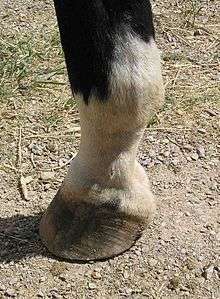Fetlock

Fetlock is the common name for the metacarpophalangeal and metatarsophalangeal joints (MCPJ and MTPJ) of horses, large animals, and sometimes dogs. It is formed by the junction of the third metacarpal (forelimb) or metatarsal (hindlimb) bones (common name: the cannon bones) proximad and the proximal phalanx distad (common name: the pastern bone). Paired proximal sesamoid bones articulate with the palmar or plantar distal surface of the third metacarpal or metatarsal bones and are rigidly fixed to the proximo-palmar/-plantar edge of the proximal phalanx.
The fetlock is a hinge joint (ginglymus), allowing flexion and extension, but minimal rotation, adduction, or abduction.
While sometimes the fetlock is colloquially referred to as an "ankle", even by horse experts, that terminology is not correct. The fetlock is a metacarpophalangeal joint which corresponds to the human upper knuckle, such as that on the ball of the foot.
Problems with the fetlock
In Thoroughbred race horses, the fetlock is involved in roughly 50% of catastrophic racing injuries.[1]
Etymology and related terminology
The word fetlock literally means "foot-lock" and originally referred to the small tuft of hair situated on the rear of the fetlock joint.[2]
"Feather" refers to the particularly long, luxuriant hair growth over the lower leg and fetlock that is characteristic of certain breeds.
See also
References
- ↑ Marquardt, Lucas. "Is this the death of synthetic racing?" (PDF). thoroughbreddailynews.com. Retrieved 9 August 2016.
- ↑ Merriam-Webster: fetlock
- Dyce KM, Sack WO, Wensing CJG. Textbook of Veterinary Anatomy (2nd Ed.). W.B. Saunders, 1996, p. 591.